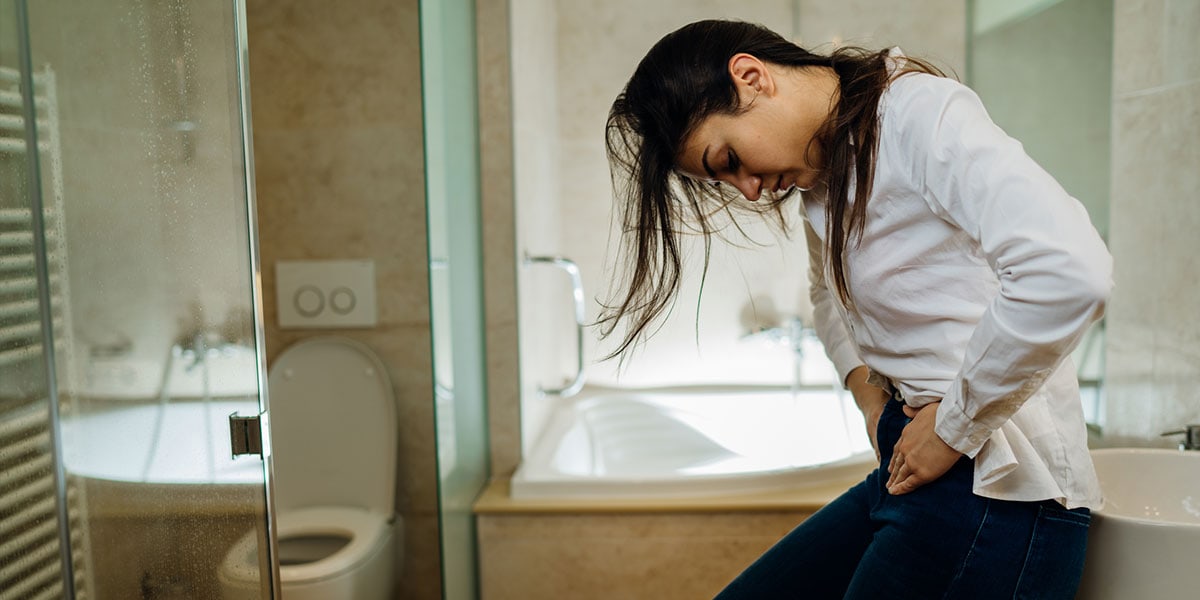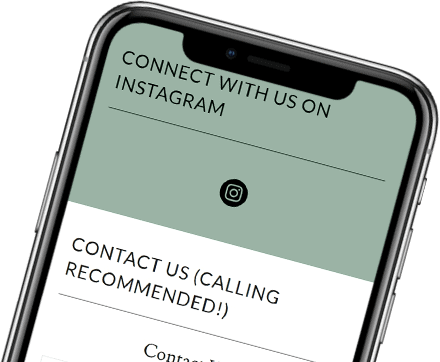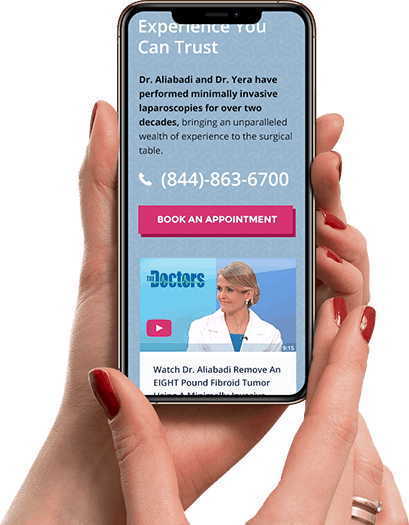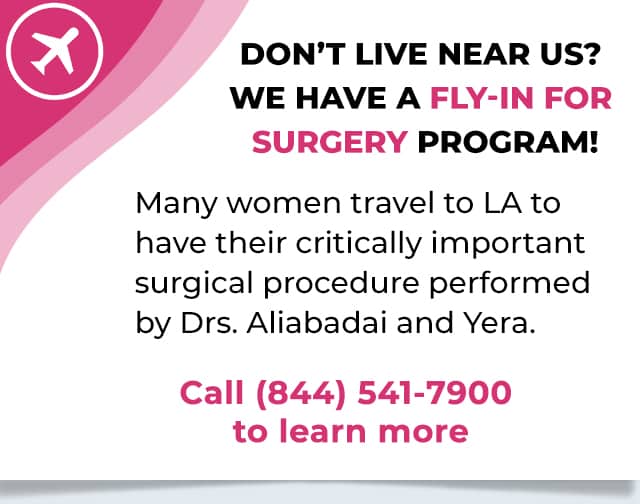Fibroids, medically known as uterine leiomyomas, are a common health concern among women. In fact, it’s estimated that 26 million women of reproductive age in the United States are living with these non-cancerous tumors. The condition disproportionately affects African American women, who are three times more likely than other women to develop fibroids and less likely to receive conservative treatment.
At the Outpatient Hysterectomy Center, we primarily focus on minimally invasive surgery. But if surgery can be avoided altogether—even better! If you’re looking for a non-surgical solution to your heavy menstrual bleeding, pelvic pain, or frequent urination caused by fibroids, look no further!

Do fibroids require surgery?
If fibroids are asymptomatic, surgery usually isn’t necessary. You may be offered more conservative treatment options instead. Despite having “hysterectomy” in our name, at the Outpatient Hysterectomy Center, we opt for the least-invasive option when possible.
Depending on the size of your fibroids, your symptoms, and your medical history, there are plenty of options we try before turning to surgery.
Non-surgical treatment options for fibroids
Non-surgical fibroid treatment can effectively manage symptoms and improve quality of life for many women. Here are some of the most common non-surgical approaches:
Gonadotropin-releasing hormone agonists
Recently, the FDA approved a new medication for noninvasive uterine fibroid treatment. Known as Gonadotropin-releasing hormone (GnRH) agonists, these medications can temporarily shrink fibroids by suppressing the production of estrogen and progesterone.
While the medication cannot cure fibroids, it can reduce their size, which may decrease your symptoms. However, because these hormones induce ovulation and the menstrual cycle, they are unsuitable for long-term use. The FDA’s approval for oral use only extends up to two years.
Obstetrics and gynecology providers may also use GnRH agonists to shrink fibroids before surgery, making them easier to remove.
Uterine artery embolization
Uterine artery embolization (UAE) is considered a minimally invasive procedure to reduce uterine blood flow and does not require an incision. Uterine fibroid embolization (UFE) is a form of UAE that blocks the flow of blood from the arteries that nourish fibroids. The fibroid shrinks when the blood supply is cut off, and symptoms often improve.
The UFE procedure involves injecting tiny particles of gelatin or specialized plastic into your arteries. Using a catheter, the tiny, body-safe particles are injected into the blood vessels that feed the fibroids. As the blood flow is cut off, the fibroid will decrease in size.
Most types of uterine artery embolization are nonsurgical, have a shorter recovery time than a myomectomy (fibroid surgery), and generally don’t necessitate a hospital stay. However, as with surgery, sedation and a general anesthetic are used for patient comfort and safety.
Focused ultrasound surgery
Another nonsurgical procedure for fibroids is focused ultrasound (FUS) therapy. In this innovative approach, MRI-guided high-intensity focused ultrasound destroys fibroids without an incision.
The procedure occurs in a magnetic resonance imaging (MRI) machine so doctors can view the pelvic area before and during treatment. Focused energy rays generate heat, which destroys the fibroid tissue. The waves pass harmlessly through skin, fat, and muscles to target the fibroid.
It’s a noninvasive option that offers quick recovery and doesn’t involve sedation, incisions, or a stay in the hospital. Additionally, after FUS fibroid eradication, most patients report quick resolution of symptoms—sometimes within just a few days.

Call 877-760-3564 or click here to schedule online
Endometrial ablation
Endometrial ablation is a uterine fibroid treatment for women with smaller fibroids who experience heavy menstrual bleeding either during or in between periods. Ablation is a technique for purposefully destroying abnormal tissue is purposefully through burning or freezing. This technique creates scar tissue on the endometrium, which in turn reduces how much it bleeds during menstruation.
Endometrial ablation involves removing or destroying the uterine lining to reduce or eliminate bleeding. Our doctor inserts the ablation device through the vagina and cervix to access the uterus. The procedure uses heat, freezing, microwave energy, or high-current radiofrequency to strip the endometrial tissue.
While ablation doesn’t destroy fibroids, we can use it to improve the heavy bleeding often accompanying them. After a consultation, we will choose the best procedure for you based on your symptoms, condition, and medical history.
Types of endometrial ablation include:
- Cryotherapy ablation. During cryotherapy ablation, freezing temperatures destroy sections of the uterine lining. Depending on your uterus shape and size, a few or multiple freeze cycles may be needed.
- Hydrothermal ablation. Hydrothermal ablation uses a heated fluid to destroy endometrial tissue. The benefit of this method is that the fluid can reach nearly every uterine cavity, even in an abnormally shaped uterus.
- Microwave ablation. Microwave energy is emitted from a device inserted into the uterus. Focused energy waves heat the wall of the uterus, destroying targeted areas of endometrial tissue.
- Radiofrequency ablation. This technique relies on targeted radiofrequency energy waves to destroy endometrial tissue
- Electrocautery ablation. Electrocautery ablation is another nonsurgical option in which a device that emits an electric current is inserted to remove uterine tissue from the walls of the uterus. It’s important to note that this type of ablation requires general anesthesia.
Over-the-counter medications
While there are no medications that will cure fibroids, some can help to manage symptoms. Over-the-counter pain relievers such as ibuprofen are often used to decrease the pain and discomfort.
Hormonal therapy is another option. Birth control pills, hormone-releasing IUDs, and hormonal injections can regulate menstrual bleeding and reduce fibroid-related symptoms. While hormonal birth control cannot destroy fibroids, it can inhibit their growth.
However, because hormonal birth control can potentially worsen some fibroid symptoms, we will carefully review all of the pros and cons before proceeding with this treatment option.
Watchful waiting
In cases where fibroids are small, asymptomatic, or you’re close to menopause, a “wait and see” approach may be recommended. Fibroids often shrink on their own after menopause. However, if your symptoms worsen, reach out to our OB/GYNs right away.
Surgical treatment for fibroids
If you have large fibroids, severe symptoms, or aren’t getting relief from non-surgical options, it may be time for surgery.
Here at the Outpatient Hysterectomy Center, we opt for laparoscopic surgery to remove fibroids. With laparoscopic surgery, we insert our tools and a lighted camera through small incisions in the abdomen. This minimally invasive surgical procedure offers less pain, scarring, and downtime than abdominal surgery, so you can get back to your normal activities sooner.
Consult Our Expert Gynecologists at the Outpatient Hysterectomy Center
If you’re concerned about fibroids or want to explore treatment options, Drs. Aliabadi and Yera are renowned renowned masters of gynecology, obstetrics, and gynecological surgery. Patients travel from around the country to be treated at the Outpatient Hysterectomy Center and Dr. Aliabadi even travels to teach her surgical expertise to other doctors. OHC is committed to providing the best women’s health care; our staff chooses the least invasive treatment option whenever possible.
We invite you to establish care with the Outpatient Hysterectomy Center. Please make your appointment online or call us at (844) 863-6700.
The Outpatient Hysterectomy Center is conveniently located for patients residing throughout Southern California and the Los Angeles area. At the Cedars-Sinai Medical Center, we are near Beverly Hills, West Hollywood, Santa Monica, West Los Angeles, Culver City, Hollywood, Venice, Marina del Rey, Malibu, Manhattan Beach, and Downtown Los Angeles.










